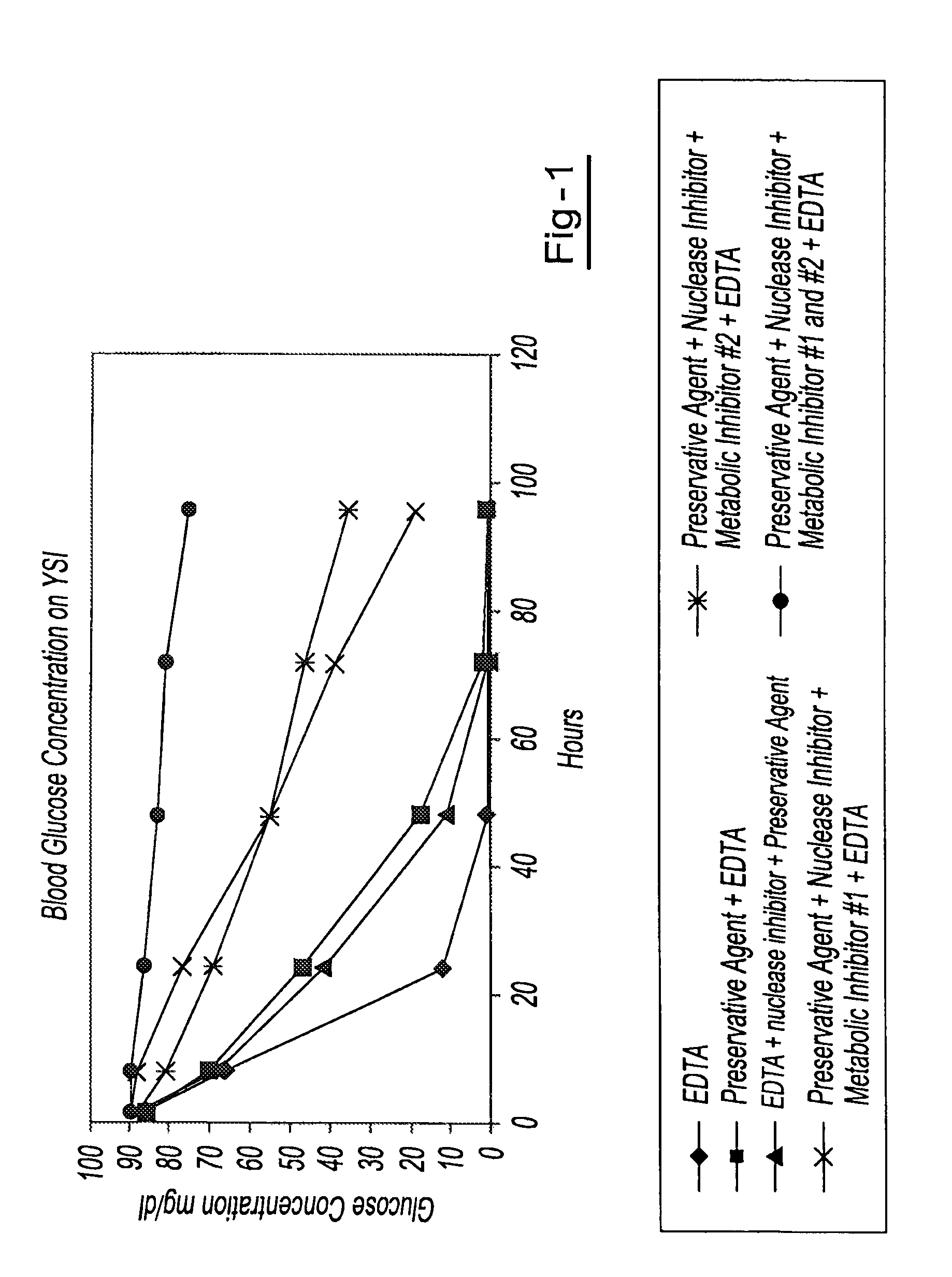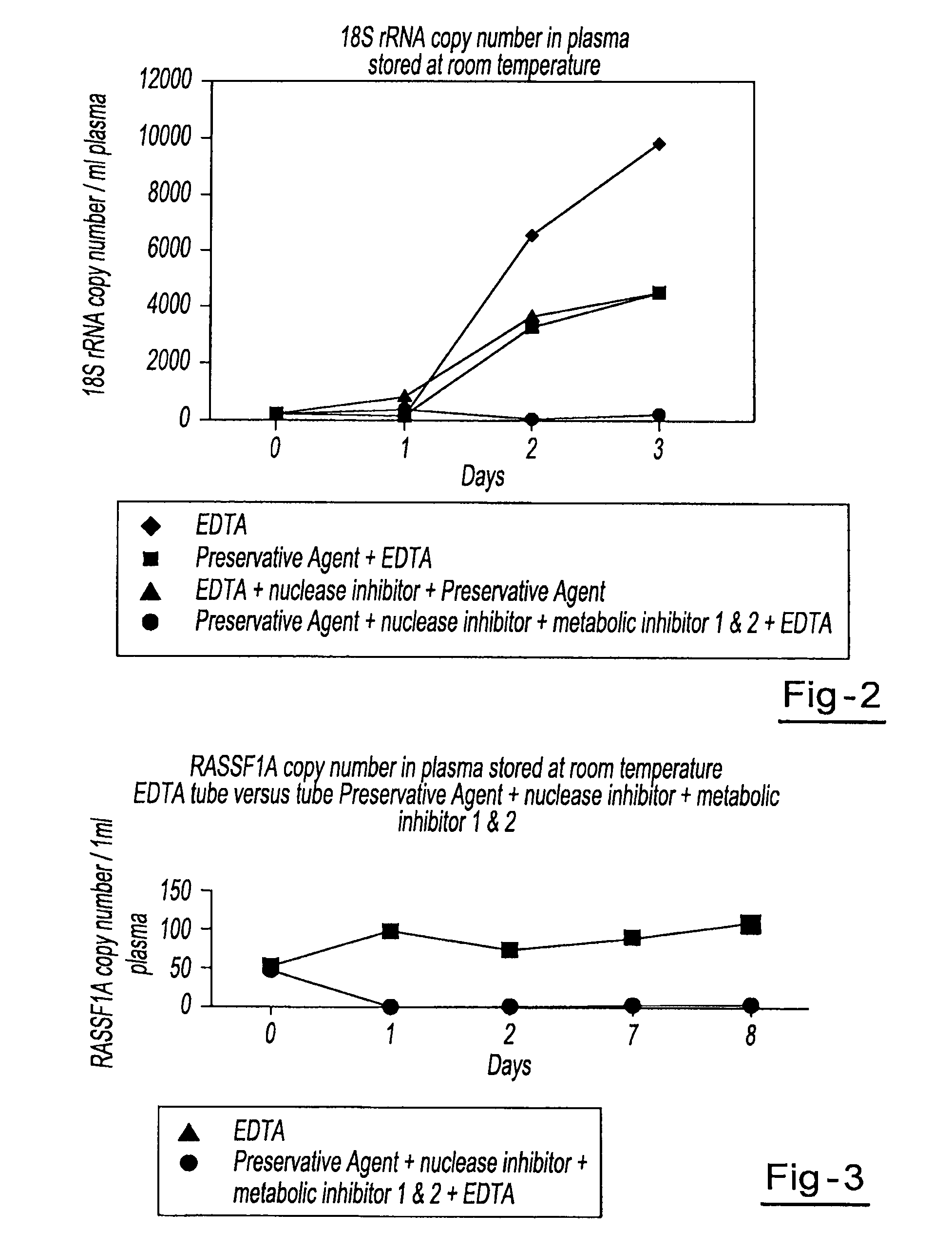Preservation of cell-free RNA in blood samples
a cell-free nucleic acid and blood sample technology, applied in the field of identification and isolation of cell-free nucleic acids in blood samples, can solve the problems of affecting the detection ability affecting the detection efficiency of cell-free nucleic acids, so as to prevent the leakage of cellular rna
- Summary
- Abstract
- Description
- Claims
- Application Information
AI Technical Summary
Benefits of technology
Problems solved by technology
Method used
Image
Examples
example 1
[0042]Blood samples from the same donor are drawn into six separate blood collection tubes (tube 1 through tube 6). Tube 1 contains only EDTA. Tube 2 contains DU and EDTA. Tube 3 contains DU, EDTA and ATA. Tube 4 contains DU, EDTA, ATA and glyceraldehyde. Tube 5 contains DU, EDTA, ATA and sodium fluoride. Tube 6 contains DU, EDTA, ATA, glyceraldehyde and sodium fluoride. All tubes are stored at room temperature and 1 ml aliquots of blood are removed from each tube at hours 1.5, 8, 24, 48, 72 and 96. The blood glucose levels of each sample are measured using a YSI blood glucose meter available from YSI Life Sciences (Yellow Springs, Ohio). The blood glucose concentration of those samples from tube 6 maintained relatively consistent glucose levels over the test period, indicating that the combination of EDTA, DU, ATA, glyceraldehyde and sodium fluoride provided reduced levels of cell metabolism. The results of this example are shown in a graphic format at FIG. 1.
example 2
[0043]Four blood samples from the same donor are drawn into four separate blood collection tubes, tube A through tube D. Tube A contains DU, EDTA, ATA, glyceraldehyde and sodium fluoride. Tube B contains DU, EDTA and ATA. Tube C contains DU and EDTA. Tube D contains only EDTA. All tubes are stored at room temperature and 1 ml aliquots of blood are removed from each tube on day 0, day 1, day 2, and day 3 and plasma is separated. All samples are centrifuged at 800 g for 10 minutes at room temperature to separate the plasma. The plasma is then transferred into new tubes and centrifuged at 1500 g for 10 minutes at room temperature. Free circulating RNA is purified using the QIAamp MinElute Virus Spin kit available from Qiagen, Inc. (Valencia, Calif.). RNA is extracted from each plasma sample. The samples are then amplified by Real Time PCR (using TaqMan® RT PCR reagents available from Applied Biosystems, Foster City, Calif.) to identify the 18S rRNA copy number per ml of plasma. Results...
example 3
[0044]Blood samples from the same donor are drawn into two separate blood collection tubes. The first tube contains DU, EDTA, ATA, glyceraldehyde and sodium fluoride. The second tube contains only EDTA. Both tubes are stored at room temperature and 1 ml aliquots of blood are removed from each tube on day 0, day 1, day 2, day 7, and day 8 and plasma is separated. All samples are centrifuged at 800 g for 10 minutes at room temperature to separate the plasma. The plasma is then transferred into new tubes and centrifuged at 1500 g for 10 minutes at room temperature. Free circulating RNA is purified using the QIAamp MinElute Virus Spin kit available from Qiagen Inc. (Valencia, Calif.). RNA is extracted from each plasma sample. The samples are then amplified by Real Time PCR (using TaqMan® RT PCR reagents available from Applied Biosystems, Foster City, Calif.) to identify fragments of β-globin and RASSF1A genes within the plasma. Results showed a consistent relative percentage of RASSF1A ...
PUM
| Property | Measurement | Unit |
|---|---|---|
| concentration | aaaaa | aaaaa |
| concentration | aaaaa | aaaaa |
| concentration | aaaaa | aaaaa |
Abstract
Description
Claims
Application Information
 Login to View More
Login to View More - R&D
- Intellectual Property
- Life Sciences
- Materials
- Tech Scout
- Unparalleled Data Quality
- Higher Quality Content
- 60% Fewer Hallucinations
Browse by: Latest US Patents, China's latest patents, Technical Efficacy Thesaurus, Application Domain, Technology Topic, Popular Technical Reports.
© 2025 PatSnap. All rights reserved.Legal|Privacy policy|Modern Slavery Act Transparency Statement|Sitemap|About US| Contact US: help@patsnap.com


